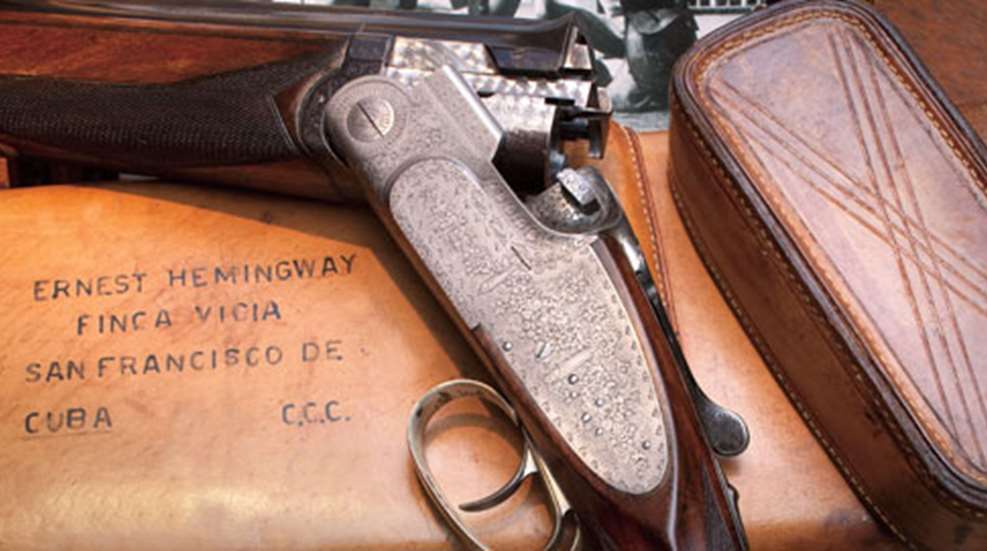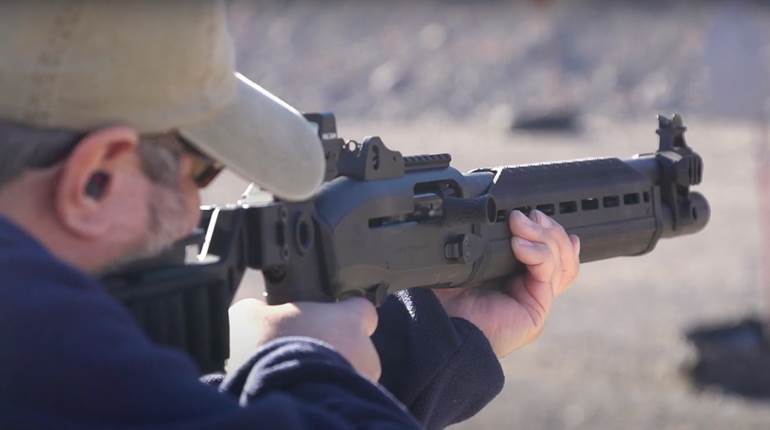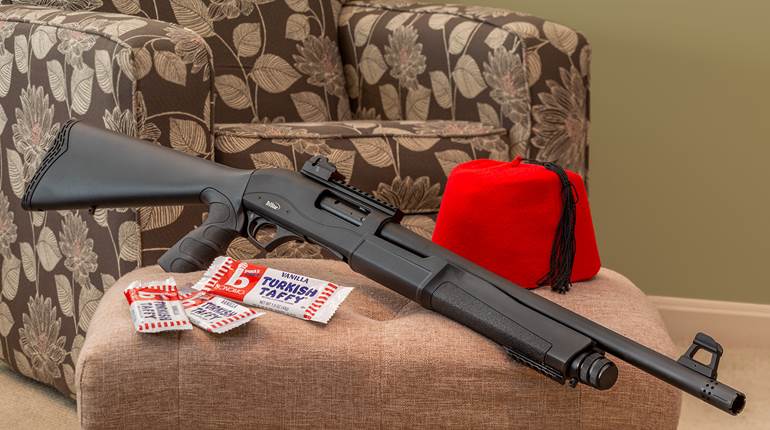
Even what seems to be a relatively well-documented Ernest Hemingway gun can lead to confusion. Author R.L. Wilson’s book “The World of Beretta” mentions that “Papa” bought a 12-gauge Beretta SO3 over-under, No. 5991, in Venice in December 1949. Mary Hemingway’s memoir, supported by letters from Ernest, recalls that in the fall of 1948 he was hunting ducks in the lagoons of Venice with a new shotgun. Beretta, however, claims that Hemingway bought the gun at Armeria Caccia, a hunting store on Venice’s Via San Marco, on Dec. 2, 1947—or was it instead shipped from the factory in nearby Val Trompia to the shop on that date? The serial number and proofmarks date the gun’s manufacture to 1947. Furthermore, the gun is marked “S3,” not “SO3.”
The accepted Hemingway chronology puts him in Idaho in October, November and December 1947 (working on “Islands in the Stream” while Taylor Williams introduced Mary to big-game hunting) and in Venice for many weeks in the autumn of 1948 and again in the winter of 1949-50. Duck hunting figures prominently in both years in Italy, but new guns appear in the memoirs and letters only in 1948, and no makers’ names are mentioned.
Was the “new gun” that Hemingway used for duck hunting with Baron Nanyuki Franchetti in 1948, when he joked that he’d been “shooting in a Venetian blind,” his W. & C. Scott—or was it this Beretta? The Armeria Caccia aside, could the Beretta have been bought alongside the Scott, from the dealer from Udine who brought guns to the Kechlers’ villa in Codroipo in the fall of 1948? Or did he buy the Scott in 1948 and the Beretta in 1949? In any event, we have found nothing in any Hemingway narratives or letters that seems to point to the Beretta.
To date, what is known about this gun comes from one famous photograph and from Book 19, p. 306, of the Abercrombie & Fitch gun ledgers, which records that on July 3, 1963, “E. Hemingway”—i.e., Mary, almost exactly two years post Ernest’s death—consigned Beretta No. 5991 to Abercrombie & Fitch for sale. The date agrees with the consignment of three other important Hemingway guns: a Winchester Model 61 .22 rifle, his Winchester Model 12 No. 525488 and his Griffin & Howe Springfield. A month later, on Aug. 9, a man named Cy Mueller bought Papa’s Beretta for $250, of which Mary received $125.
The Abercrombie & Fitch records are a unique window on American society. On the same day, Aug. 9, 1963, the company sold a matched pair of Jos. Lang guns that had been consigned by Bernard Baruch, the financier and statesman. Those guns brought $4,500; Baruch netted $3,000.
In somewhat sloppy handwriting, an employee described the Beretta as a 12-gauge over-under, no model name or number given, weighing 7 pounds, in a “fleese” [sic] case, with 27 1/2-inch barrels choked “Full/Full” and 2 3/4-inch chambers. Full and full is an unusual choke arrangement; Beretta now lists the chokes as modified and full, which is more normal. And rather than a “fleese” case, a description that calls to mind a full-length, zippered leather or cloth sleeve, when Beretta re-acquired the gun in 1999 it was in a hard leather leg-o’-mutton case stamped with Hemingway’s name and Cuban address.
It would be nearly impossible for Ernest Hemingway, an ardent hunter and shooter who favored double guns and who spent so much time in northern Italy, not to have acquired a Beretta somewhere along the way.
Between Milan and Venice lies the city of Brescia—equally ancient and historic, if less glamorous and less well known outside Italy. Brescia is on the Mella River at the mouth of Val Trompia, a valley that funnels southward out of the Pre-Alps. From the beginning its primary product was arms. It began with edged weapons and armor, and then crossbows. With the development of “hand cannons” came a parallel evolution of manufacturing technology. By 1509, Pietro Francino di Gardone had built a water-powered forge that could pound out 10 barrel blanks per day.
Brescia now makes auto parts and machine tools, but the flagship industry of Gardone, Marcheno and Sarezzo, the towns that lie farther up in Val Trompia, continues to be firearms. In this tangle of winding streets and modest stone and stucco buildings, most kinds of sporting gun are made, from target pistols to reproductions of historic muzzleloaders to big-game rifles, and, of course, shotguns. According to the chamber of commerce, there are more than 150 companies in the valley engaged in some aspect of building guns. Virtually all of them are family enterprises; some are individual craftsmen; many are tiny boutique firms with a handful of employees. One of them, however, is a privately held, multinational conglomerate that is recognized as the oldest industrial firm in existence: Fabbrica d’Armi Pietro Beretta S.p.A.
Today the Beretta family’s ancestral home in Gardone is nearly hidden among slightly grimy industrial buildings. Nearby is the company’s headquarters and private museum. In the files is a receipt from the office of the Doge of Venice that translates as follows: “On this, the 3rd day of October 1526. [To] Master Bartolomeo Beretta of the Brescian territory of Gardone for 185 arquebus barrels [made] for our House of the Arsenal [is given] 296 ducats.”
Bartolomeo’s foundry has grown into one of the most technologically sophisticated and successful makers of sporting, police and military firearms that today owns at least eight other gun companies and does business around the world. The modern firm’s name honors Pietro Beretta, born in 1791, because it was he who launched its aggressive expansion, which his son Giuseppe continued by opening up export markets. Sixteen generations of Berettas have been active in the company, which is currently managed by Ugo Gussalli Beretta and his sons Pietro and Franco.
After World War II, Beretta’s output of sporting shotguns shifted to over-unders. The Sovrapposto, Beretta’s answer to John Browning’s Superposed B25 of 1930, made its public debut in 1933 or 1934. The 1935 Beretta catalog listed three versions: S.01 and S.02 “Super Hunter” models and an S.03 “Super Tiro” competition gun, all in 12 gauge and “patented 1934.” The more lavishly engraved S.02’s list price was 2,650 lira, officially equivalent then to $140. That was about 40 percent more than a B25, but a buyer with cash U.S. dollars could probably have gotten a much better black-market price in Italy at the time. (This would have been even more so in late-1940s, post-war Italy, when Hemingway bought his S3.)
Beretta’s 1938 catalog explained, in translated English, that the company’s designers had found solutions to the “problems” of over-unders made by “the best known foreign factories.” Instead of a full-width hinge beneath the action, Beretta let its barrels pivot on pins set into the sides of the action body and adopted the Kersten Verschluss from Germany, which put the locking lugs in line with the top barrel instead of under the bottom one. The result was a shotgun action that was both as streamlined as the Boss and as strong as the Merkel. This amounted to just common-sense applications of sound, existing technology to suit the Italian design esthetic, but Beretta went a step further and refined a barrel-jointing technique patented in 1881 by a Belgian named Henri Pieper. With Beretta’s marketing might behind it, this would now reverberate through the gunmaking world just as loudly as Anson & Deeley’s English action patent did in 1875.
Instead of building pairs of barrels by painstakingly aligning and soldering two tubes to each other and then machining the hinge and latch surfaces into their breech ends, as everyone else did, Pieper fabricated the breech portion first, out of a block of steel, and then simply screwed the barrel tubes into sockets threaded into the block. By 1913 Beretta had adopted this method but was soldering thin-walled tubes into the block instead of using Pieper’s screw threads. This reduced bulk and weight. Beretta then also added the ejector mechanisms to the block, another step that simplified the manufacture of double guns.
In the late 1920s or early ’30s, when developing its first breechloading Sovrapposto guns, Beretta used this so-called monobloc technique. It was widely adopted in Val Trompia and eventually elsewhere, and one of the characteristics of Italian double guns is often a telltale seam in the barrels—usually decorated with a ring of engraving—just forward of the hinge pin, where the ends of the tubes butt up against the block. Italian makers of bespoke guns now offer their clients the choice of “monobloc” or the more expensive traditional barrels, with seamless tubes (called “demibloc” in Europe), but Ernest Hemingway’s S3, a top-of-the-line model in its day, has this distinctive line.
Although their prices were far closer to the boxlock Browning Superposed made in Belgium than to the sidelock Boss- and Woodward-type guns from London, S-series Berettas from the beginning were built with sidelock actions. (“Lock” here means the mechanism by which a gun fires its ammunition, not how the action is fastened shut.) Each lock—the arrangement of cams, sears, springs and tumbler that detonates the cartridge—of a sidelock gun is mounted on a long oval plate inletted into the side of the stock at its head, where it meets the body of the gun. This is regarded as more esthetically pleasing than the simpler boxlock action, which contains its firing apparatus in a squared-off action “box” between the buttstock and barrels. A sidelock has some theoretical advantages in the geometry of its trigger linkage, and its sideplates offer a larger “canvas” for engraving; a boxlock is less complex and stronger but can look chunky, especially when it has been designed for mass production.
At the 1964 Olympics an Italian named Ennio Matterelli won the gold medal in trapshooting with an over-under made in Italy by Daniele Perazzi. The shooting world, and in particular America, took notice, and Beretta was positioned to take advantage of this promotional coup. Today the company’s mass-produced over-unders dominate the market worldwide, while its limited-production bespoke over-unders command huge prices. Modern Italian gunmakers, to a man (and woman), hold England’s great houses—Purdey, Boss, Holland & Holland, Greener, Westley Richards, et al.—in the highest esteem for their side-by-side guns but with the next breath proudly point to their own over-unders as the finest of their kind. Italy has refined the over-under shotgun to a standard found nowhere else, and Beretta makes this tradition accessible to shooters of all pocketbook sizes.
In its Oct. 5, 1999 catalog, the day when Beretta S3 No. 5991 went under the gavel, Mapes Auction Gallery noted that the gun and “about 17 or 18 others remained in Africa until 1964 when they were shipped to Abercrombie & Fitch Co., New York, to be offered for sale by Mary Hemingway.”
In 1964 Mary recalled that she and Ernest had 18 to 20 guns on their 1953-’54 safari, but we are certain of only eight of them: the Model 12 and W. & C. Scott shotguns; the Griffin & Howe, Model 61, Mannlicher and Westley Richards rifles; and probably two Woodsman pistols. It is true that Papa and Mary left Kenya without their guns (at least some of them) after that safari. Ernest, already battered from two bush-plane wrecks on January 23 and 24, compounded his injuries by falling into a brush fire while recuperating at a beach cottage at Shimoni, 50 miles south of Mombasa. Less than a week later, with Ernest all but invalided, Mary bundled him aboard the S.S. Africa for Venice by way of Port Said. There was no opportunity to pack properly and make all of the planned goodbyes. Five or six months later, when the Hemingways were at home in Cuba, a letter arrived from their friend William Hale, head of the Kenya Game Department. Along with reminding them that they owed the equivalent of $58.57 for extra game they had shot, Hale wrote that he had deposited Ernest’s guns in the bank for safekeeping. (Denis Zaphiro had probably taken charge of them after the Hemingways’ disorganized departure, and then handed them off to his boss, Hale.) However, the guns were returned long before 1964: Arnold wrote of seeing the Model 12 in 1958; Papa probably put the Scott to deadly use in July 1961; and Mary consigned two of the known safari guns to Abercrombie & Fitch for sale in 1963. Of this Beretta, also consigned, we have found no indication, written or photographic, that it was taken on safari.
The Mapes catalog also mentions a letter from Abercrombie & Fitch, dated March 5, 1964, “verifying that this shotgun, serial number 5991, did indeed belong to Ernest Hemingway.” The letter seems to have vanished; neither Mapes nor Beretta have it, and there is no copy in the Abercrombie & Fitch records. The gun, however, is now on display at the Beretta Gallery at 718 Madison Avenue in New York City.





































